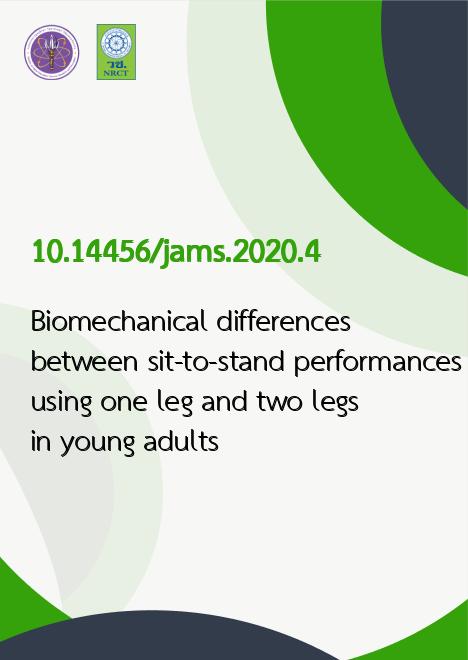
|
Biomechanical differences between sit-to-stand performances using one leg and two legs in young adults |
|---|---|
| รหัสดีโอไอ | |
| Creator | 1. Surachart Thongchoomsin 2. Sunee Bovonsunthonchai 3. Samatchai Chamnongkich |
| Title | Biomechanical differences between sit-to-stand performances using one leg and two legs in young adults |
| Publisher | Faculty of Associated Medical Sciences, Chiang Mai University |
| Publication Year | 2563 |
| Journal Title | Journal of Associated Medical Sciences |
| Journal Vol. | 53 |
| Journal No. | 1 |
| Page no. | 29-36 |
| Keyword | sit-to-stand test, one-leg sit-to-stand movement, ground reaction force, kinematics, joint kinetics |
| URL Website | https://www.tci-thaijo.org/index.php/bulletinAMS/index |
| Website title | Journal of Associated Medical Sciences |
| ISSN | 25396056 |
| Abstract | Background: Sit-to-stand (STS) test is widely used as a functional test for the assessment of lower extremity function in the elderly. Performing the STS movement with one-leg was introduced as an assessment of lower extremity muscle strength in young adults; however, the biomechanical differences between the traditional two-leg STS movement and one-leg STS movement have not been reported. The purposes of this study were to characterize and compare the kinematic and kinetic differences between the one-leg and two-leg STS movements. Materials and methods: Fifteen young adults (8 men and 7 women) with mean age 26.18ฑ3.88 years participated in this study. The kinematic and kinetic data during one-leg and two-leg STS testing conditions were collected and analyzed using force plates and a three-dimensional motion analysis system. Results: Performance time was significantly longer in the one-leg STS condition than the two-leg STS condition (p |